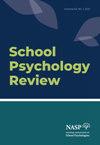Measuring Fairness and Justice in the Classroom: A Systematic Review of Instruments’ Validity Evidence
IF 3
3区 心理学
Q1 Social Sciences
引用次数: 4
Abstract
Abstract Empirical research in education has largely adopted quantitative approaches to measure teachers’ and students’ perceptions of fairness and justice in classroom contexts. The purpose of this study is to understand the validity evidence of fairness and justice instruments including how fairness and justice have been conceptualized in measures. Through a systematic review method, 96 quantitative studies were identified and their measurement instruments were analyzed based on five validity criteria: (a) framework and conceptualization of construct, (b) response processes, (c) internal structure, (d) internal consistency reliability, and (e) relationship to other variables. Results showed that most studies conceptualized classroom fairness and justice from organizational and social psychological theories with only a few conducting rigorous statistical analyses to support their validity interpretations. Findings are critically discussed and point to the need to develop a theory of fairness and justice rooted in classroom contexts. Impact Statement By reviewing the quality of classroom fairness instruments, this study provides guidance to school psychologists, teachers, and educational researchers with the choice of reliable instruments to promote fairer school culture and climate that supports students’ academic engagement and motivation as well as mental health at schools. Supplemental data for this article can be accessed online at https://doi.org/10.1080/2372966X.2021.2000843. Supplemental data for this article is available online at https://doi.org/10.1080/2372966X.2021.2000843 .课堂公平正义的度量——对工具有效性证据的系统考察
摘要教育实证研究在很大程度上采用了定量方法来衡量教师和学生在课堂环境中对公平和正义的看法。本研究的目的是了解公平和正义工具的有效性证据,包括公平和正义是如何在措施中概念化的。通过系统回顾方法,确定了96项定量研究,并基于五个有效性标准对其测量工具进行了分析:(a)结构的框架和概念化,(b)反应过程,(c)内部结构,(d)内部一致性可靠性,以及(e)与其他变量的关系。结果表明,大多数研究从组织和社会心理学理论中概念化了课堂公平和正义,只有少数研究进行了严格的统计分析来支持其有效性解释。对研究结果进行了批判性的讨论,指出有必要发展一种植根于课堂环境的公平正义理论。影响声明通过审查课堂公平工具的质量,本研究为学校心理学家、教师和教育研究人员提供了选择可靠工具的指导,以促进更公平的学校文化和氛围,支持学生的学术参与和动机以及学校的心理健康。本文的补充数据可在线访问:https://doi.org/10.1080/2372966X.2021.2000843.本文的补充数据可在线获取,网址为https://doi.org/10.1080/2372966X.2021.2000843。
本文章由计算机程序翻译,如有差异,请以英文原文为准。
求助全文
约1分钟内获得全文
求助全文
来源期刊

School Psychology Review
Social Sciences-Education
CiteScore
6.90
自引率
20.00%
发文量
54
期刊介绍:
School Psychology Review (SPR) is a refereed journal published quarterly by NASP. Its primary purpose is to provide a means for communicating scholarly advances in research, training, and practice related to psychology and education, and specifically to school psychology. Of particular interest are articles presenting original, data-based research that can contribute to the development of innovative intervention and prevention strategies and the evaluation of these approaches. SPR presents important conceptual developments and empirical findings from a wide range of disciplines (e.g., educational, child clinical, pediatric, community.
 求助内容:
求助内容: 应助结果提醒方式:
应助结果提醒方式:


